9. Marriage and Population
in Japan
@28/Sep/2005
RSS Eurasia Club/JICA SV in RSS Amman Jordan
[Purposes]
[Coordinator Office]
[Schedule]
[Materials]
[Top]
1. Abstract:
It would be a shocking fact that the population of Japan will be cut half
in next 100 years. Number of children that Japanese woman bear in her entire
life is constantly decreasing each year. This number had already been reached
a real alarming level of 1.32 child/woman in 2002. However, thanks to longevity
of Japanese elder keeps unbeatable top in the world, total population will
barely keep increasing till 2006. The turning point would be 2006, the
population of Japan will never increase, but starts to decrease ever after.
To get married and bear the child is the most simple natural law of the
divine creature. Human being would be the top of all creature on earth
below the God. Something going wrong in marriage and bearing child in Japan.
Age of the first marriage had ever been older and number of child beard
by women has ever been decreasing. It seems that no one could stop this
truly dangerous social phenomenon.
This is the time for Japanese people in history to take one important and
decisive action to curb the vicious problem ever encountered. Or take their
way to the total nightmare.
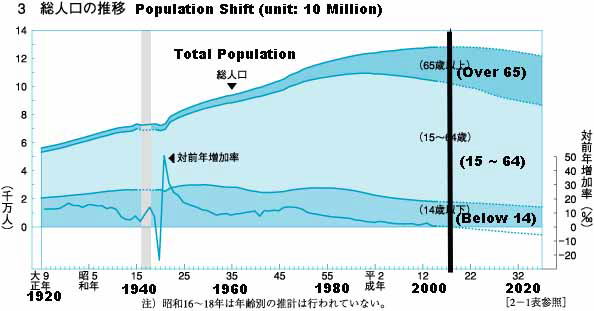
Fig.1 Population of Japan will start decreasing from 2006, reach half of the present in next 100 years
2. Historical Concerning of the Marriage in Japan
In the past, the marriage in Japan is rather different style that we have today. Marriage ceremony was rather simple and less costly. It had been a long custom in Japan that a man visit at night secretly to the girl's house and asked to the girls marry to him. If the girl accepted his offer, the girl's family accept his offer to marry his daughter. A simple ceremony had been set up to announce the marriage and celebrate it. For a certain period after they married, a husband lived together with girl's family as a training period of housework. They moved to husband house, when the wife got her confidence to do all the house works by herself.
During feudal period in 12 century, marriage style of the top class people
had been changed similar to present style. A wife moves into husband house
from the day of the marriage. This style had been followed by other ordinal
people. From this period, go-between had been set up by both family and
make marriage more solid and disciplined to prevent easy divorce after
the marriage. Engagement gift was introduced in these days. A family of
boy presents the engagement gift (usually cash) to the family of girl.
Amount of the engagement gift varies largely depend on families involved.
In average, it is approximately US$ 10,000. The family of wife to be prepare
her wedding costumes and others using the gift and return a part of the
gift by memorial goods to the family of husband to be. In this style of
marriage, the girl has no time of training to be a housewife. So, the newly
married wife usually had hard time until she learn enough all the necessary
house works in her husband house.
A marriage ceremony in Shintou Style becomes wide spread all over Japan after the Meiji Era. The first Shintou style wedding ceremony had held in 1908. Since then, Shintou Style Wedding ceremony has been supported among the people due to rather simple to perform and having dignity of the ceremony.
In '70s and '80s, Japan was enjoying super economic growth and people becomes
considerably rich in short period, the wedding ceremony had also became
inflated so much. People had preferred more expensive and luxurious ceremony.
Wedding had became one of the major money making business. Many exclusively
made gorgeous wedding halls had been build in the capital cities and major
local cities. People spend fortunes to their wedding event at that time.
After '80s, economy of Japan had been matured and stabilized, no big economic
growth expected anymore. People got back to reconsidered their life style
and their spending. Today, wedding is still gorgeous, but they make every
effort to cut the cost much as possible, leaving dignity and gorgeousness
as maximum.
Another big change in family style in Japan is popping up nuclear family that consists only from husband, wife and their children. They no longer live together with their parents family. This has been created both problems and new business opportunities. These would be discussed in separate occasion.
3. Marriage Ceremony:
The marriage ceremony in Japan is performed in various styles, like Shintou-Style
(Performed in the Shintou Shrine), Buddha-Style (Performed in the Buddhist
Temple), Christian-Style (Performed in Christian Church) and etc. Currently,
some 80 % of all are in Shintou-Style. Usually, a big banquet party follows
right after the wedding ceremony. Number of guest invited to the party
is around 70 to 150, but it varies largely depend on the family involved.

One of the typical Ceremony in Shintou-Style

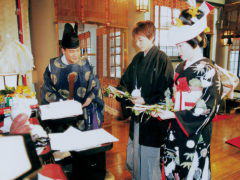
Under the guidance of shrine monk, bride and bridegroom pledge their wedding contract in front of Shintou Shrine Alter
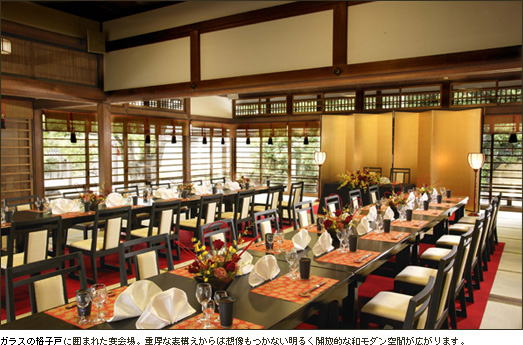
Bride and bridegroom sit in front of them and entertain the guests
Attire usually worn by the couple is pure Japanese style except ceremony performed in the Church where western wedding dress is worn. Most traditional attire is Juuni-Hitoe, that consists of 11 inner dress and one gorgeous outer Kimono. Ordinal wedding dress is silk-made luxurious Kimono that usually rented only for the ceremony purpose. In the banquet parties, the bridegroom often changes her attire from Japanese Kimono style to western dress at least once to entertain the guests and display herself more attractive.

Formal attire of wedding of Prince Akihito to Masako


A set of Juni-Hitoe (12 Folded Kimono)
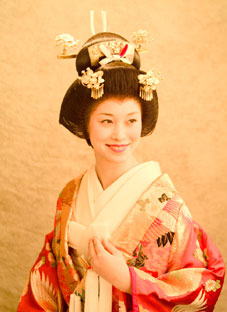

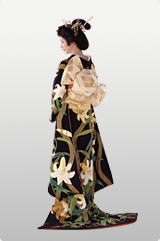
Example of Typical Wedding Kimono
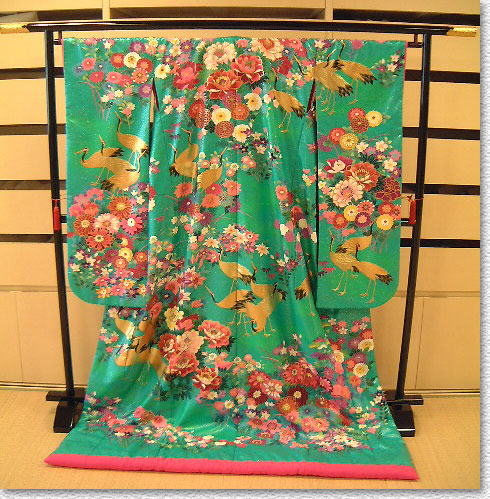
Example of Wedding Kimono Display-1

Example of Wedding Kimono Display-2
4. Cost:
People always wary about the cost of marriage. Especially young couple
often could not afford for it by themselves. If the family of the couple
is wealthy enough, the families of the couple share the major part of the
cost to show the dominance of their family in community at large. Otherwise,
the couple may borrows their wedding funds from bank or relatives, or reduce
the cost in every possible way, for example deleting ceremony and banquets
completely and simply resister their marriage at the city office where
they belong to. One of the trend that couples are willing to choose recently
is having wedding ceremony and party in abroad, for example, in Hawaii
or Australia in order to reduce the cost. The cost of wedding in Japan
has sharply increased, so that even counting travelling coat to abroad,
total cost of the wedding will be suppressed compared to having one in
Japan.
Typical example of the cost of wedding in Japan is shown below.
|
1996 (in US$) |
||||
|
Total |
Husband |
Wife |
||
|
Engagement |
16,400 |
13.700 |
2,700 |
|
|
|
Engagement & Return |
8,500 |
7,600 |
900 |
|
Wedding Ceremony and Party |
35,900 |
20,500 |
15,500 |
|
|
|
Ceremony & Party |
31,200 |
17,600 |
13,600 |
|
Honey Moon Trip |
8,000 |
5,100 |
3,600 |
|
|
Preparation for marriage life |
26,800 |
10,000 |
26,500 |
|
|
|
Furniture, Electronic appliances, Table ware Clothes |
16,000 |
3,100 |
12,900 |
|
Total Cost |
87,900 |
47,900 |
39,900 |
|
|
Total Balance |
79,400 |
47,100 |
32,300 |
|
5. Statistics of Marriage in Japan:
It is a general trend that age of marriage is getting older in many part
of the world. This trend is also inevitably seen in Japan without left
behind. There would be many factors behind the scene. One of them is the
sky rocketing rise of cost of marriage and the life afterward, or education
and housing cost for their children and family. Another is that great many
choice of pleasures are provided in modern life besides marriage for both
sexes. People finds fun and too much busy than thinking of marriage and
healthy growth of family and nation. Neutralization of sexes is prevailing
all over the world that includes Japan. They often does not feel strong
instinct to the other sex than feeling as the same human being. There would
be many other reasons, but I could not name all of them instantly.
In below table, some of the statistical facts are shown.
| 1970 | 1975 | 1980 | 1985 | 1990 | 1995 | 1997 | 1998 | 1999 | 2000 | |
| All Type of Marriage | ||||||||||
| Husband | 27.6 | 27.8 | 28.7 | 29.3 | 29.7 | 29.8 | 29.9 | 30.0 | 30.2 | 30.4 |
| Wife | 24.6 | 25.2 | 25.9 | 26.4 | 26.9 | 27.3 | 27.6 | 27.7 | 27.9 | 28.2 |
| First Marriage | ||||||||||
| Husband | 26.9 | 27.0 | 27.8 | 28.2 | 28.4 | 28.5 | 28.5 | 28.6 | 28.7 | 28.8 |
| Wife | 24.2 | 24.7 | 25.2 | 25.5 | 25.9 | 26.3 | 26.6 | 26.7 | 26.8 | 27.0 |
| Marriage after Divorce | ||||||||||
| Husband | 38.0 | 37.8 | 38.2 | 39.4 | 40.1 | 40.3 | 40.4 | 40.4 | 40.5 | 40.7 |
| Wife | 33.2 | 33.2 | 34.1 | 35.7 | 36.5 | 36.9 | 36.9 | 36.9 | 37.1 | 37.2 |
Table-2 Age of marriage in Japan
6. Future Vision in Marriage and the Population:
An urgent governmental action is required in order to cure the population
problem in Japan. It must be implemented immediately to cure the society
where people could foster the healthy family with enough number of children
to sustain the nation with their own will. Otherwise, Japan will, without
mistake, stumble down to the bottom where only poverty prevail all over.
The year 2006 is the epoch-making year, from that point, our population
starts to decrease. There would be several measures to be considered to
implement, like;
2. Big incentive to bear more child to newly wed
3. Low cost children cares for both working young couples
4. Provision of opportunities to work for the people beyond 60 years old
5. None
In which direction we are going to head, it is rendered to the people of the nation. Whatever the measure is taken, it would be the hard way to process it and get the favorable results in short period of time. But not much time is left. Only few score of year is left for us until we reach to the catastrophic situation..
| [Coordinator Office] [Purposes] [Schedule] [Materials] [Top] |
| [Back to Page Top] |